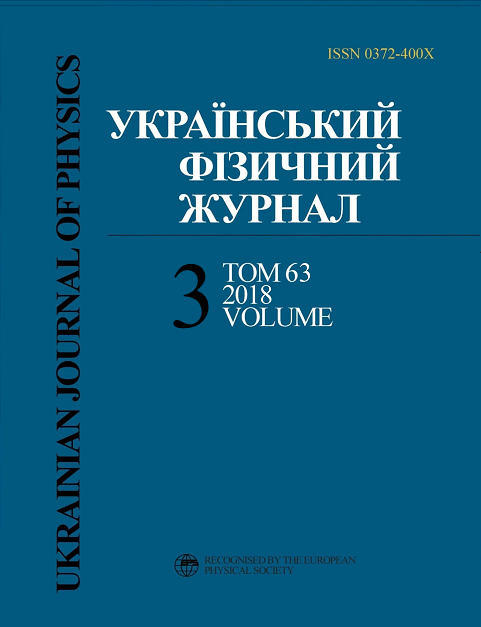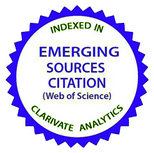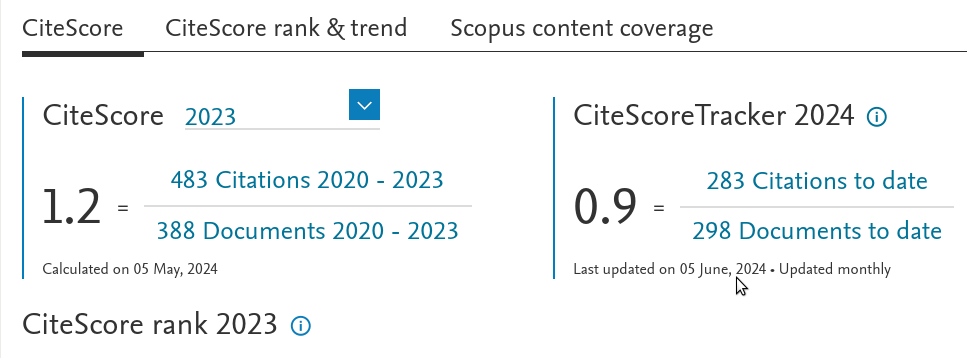Аналітичний підхід щодо розрахунку функції чутливості хемотаксису
DOI:
https://doi.org/10.15407/ujpe63.3.255Анотація
Дослiджується проблема хемотаксису для одновимiрної системи. Аналiз взаємодiї бактерiй з атрактантом виконується на основi модифiкованої моделi Келлера–Зегеля. Для опису системи використовується функцiя чутливостi хемотаксису, яка є характеристикою неоднорiдностi розподiлу бактерiй. Зокрема, вивчається питання про те, як функцiя чутливостi хемотаксису залежить вiд концентрацiї атрактанту на границях системи. Вiдомо, що системи без абсорбцiї атрактанту описуються функцiєю чутливостi хемотаксису з максимумом куполоподiбної форми. В данiй роботi показано, що абсорбцiя атрактанту та спецiальнi граничнi умови можуть зумовити виникнення додаткового максимуму у функцiї чутливостi хемотаксису. Величина такого максимуму визначається iнтенсивнiстю абсорбцiї атрактанту.
Посилання
<li>J.D. Murray. Mathematical Biology: I. An Introduction (Springer, 2007).
</li>
<li>H.C. Berg. E. coli in Motion (Springer, 2004).
<a href="https://doi.org/10.1007/b97370">https://doi.org/10.1007/b97370</a>
</li>
<li>J. Adler. Chemotaxis in bacteria. Science 153, 708 (1966).
<a href="https://doi.org/10.1126/science.153.3737.708">https://doi.org/10.1126/science.153.3737.708</a>
</li>
<li>R.M. Macnab, D.E. Koshland. The gradient-sensing mechanism in bacterial chemotaxis. Proc. Natl. Acad. Sci. USA 69, 2509 (1972).
<a href="https://doi.org/10.1073/pnas.69.9.2509">https://doi.org/10.1073/pnas.69.9.2509</a>
</li>
<li>H.C. Berg, D.A. Brown. Chemotaxis in Escherichia coli analysed by three-dimensional tracking. Nature 239, 500 (1972).
<a href="https://doi.org/10.1038/239500a0">https://doi.org/10.1038/239500a0</a>
</li>
<li>T. Namba, M. Nishikawa, T. Shibata. The relation of signal transduction to the sensitivity and dynamic range of bacterial chemotaxis. Biophys. J. 103, 1390 (2012).
<a href="https://doi.org/10.1016/j.bpj.2012.08.034">https://doi.org/10.1016/j.bpj.2012.08.034</a>
</li>
<li>B.A. Camley, J. Zimmermann, H. Levine, W.-J. Rappel. Emergent collective chemotaxis without single-cell gradient sensing. Phys. Rev. Lett. 116, 098101 (2016).
<a href="https://doi.org/10.1103/PhysRevLett.116.098101">https://doi.org/10.1103/PhysRevLett.116.098101</a>
</li>
<li>A. Geiseler, P. H?anggi, F. Marchesoni, C. Mulhern, S. Savel'ev. Chemotaxis of artificial microswimmers in active density waves. Phys. Rev. E 94, 012613 (2016).
<a href="https://doi.org/10.1103/PhysRevE.94.012613">https://doi.org/10.1103/PhysRevE.94.012613</a>
</li>
<li>S. Dev, S. Chatterjee. Optimal search in E. coli chemotaxis. Phys. Rev. E 91, 042714 (2015).
<a href="https://doi.org/10.1103/PhysRevE.91.042714">https://doi.org/10.1103/PhysRevE.91.042714</a>
</li>
<li> P. Romanczuk, G. Salbreux. Optimal chemotaxis in intermittent migration of animal cells. Phys. Rev. E 91, 042720 (2015).
<a href="https://doi.org/10.1103/PhysRevE.91.042720">https://doi.org/10.1103/PhysRevE.91.042720</a>
</li>
<li> M. Ebrahimian, M. Yekehzare, M.R. Ejtehadi. Low-Reynolds-number predator. Phys. Rev. E 92, 063035 (2015).
<a href="https://doi.org/10.1103/PhysRevE.92.063035">https://doi.org/10.1103/PhysRevE.92.063035</a>
</li>
<li> M. Leoni, P. Sens. Polarization of cells and soft objects driven by mechanical interactions: Consequences for migration and chemotaxis. Phys. Rev. E 91, 022720 (2015).
<a href="https://doi.org/10.1103/PhysRevE.91.022720">https://doi.org/10.1103/PhysRevE.91.022720</a>
</li>
<li> M. Meyer, L. Schimansky-Geier. Active Brownian agents with concentration-dependent chemotactic sensitivity. Phys. Rev. E 89, 022711 (2014).
<a href="https://doi.org/10.1103/PhysRevE.89.022711">https://doi.org/10.1103/PhysRevE.89.022711</a>
</li>
<li> J. Zhuang, G. Wei, R.W. Carlsen, M.R. Edwards, R. Marculescu, P. Bogdan, M. Sitti. Analytical modeling and experimental characterization of chemotaxis in Serratia marcescens. Phys. Rev. E 89, 052704 (2014).
<a href="https://doi.org/10.1103/PhysRevE.89.052704">https://doi.org/10.1103/PhysRevE.89.052704</a>
</li>
<li> T. Sagawa, Y. Kikuchi, Y. Inoue, H. Takahashi, T. Muraoka, K. Kinbara, A. Ishijima, H. Fukuoka. Single-cell E.coli response to an instantaneously applied chemotactic signal. Biophys. J. 10, 730 (2014).
<a href="https://doi.org/10.1016/j.bpj.2014.06.017">https://doi.org/10.1016/j.bpj.2014.06.017</a>
</li>
<li> Y. Tu, T.S. Shimizu, H.C. Berg. Modeling the chemotactic response of Escherichia coli to time-varying stimuli. Proc. Natl. Acad. Sci. USA 105, 14855 (2008).
<a href="https://doi.org/10.1073/pnas.0807569105">https://doi.org/10.1073/pnas.0807569105</a>
</li>
<li> D.A. Clark, L.C. Grant. The bacterial chemotactic response rejects a compromise between transient and steady-state behavior. Proc. Natl. Acad. Sci. USA 102, 9150 (2005).
<a href="https://doi.org/10.1073/pnas.0407659102">https://doi.org/10.1073/pnas.0407659102</a>
</li>
<li> P.G. de Gennes. Chemotaxis: The role of internal delays. Eur. Biophys. J. 33, 691 (2004).
<a href="https://doi.org/10.1007/s00249-004-0426-z">https://doi.org/10.1007/s00249-004-0426-z</a>
</li>
<li> R. Tyson, S.R. Lubkin, J.D. Murray. A minimal mechanism of bacterial pattern formation. Proc. Roy. Soc. Lond. B 266, 299 (1999).
<a href="https://doi.org/10.1098/rspb.1999.0637">https://doi.org/10.1098/rspb.1999.0637</a>
</li>
<li> E.O. Budrene, H. Berg. Complex patterns formed by motile cells of Escherichia coli. Nature 376, 49 (1995).
<a href="https://doi.org/10.1038/376049a0">https://doi.org/10.1038/376049a0</a>
</li>
<li> E. Ben-Jacob, O. Schochet, A. Tenenbaum, I. Cohen, A. Czirok, T. Vicsek. Generic modelling of cooperative growth patterns in bacterial colonies. Nature 368, 46 (1994).
<a href="https://doi.org/10.1038/368046a0">https://doi.org/10.1038/368046a0</a>
</li>
<li> M.J. Schnitzer. Theory of continuum random walks and application to chemotaxis. Phys. Rev. E 48, 2553 (1993).
<a href="https://doi.org/10.1103/PhysRevE.48.2553">https://doi.org/10.1103/PhysRevE.48.2553</a>
</li>
<li> E.F. Keller, L.A. Segel. Travelling bands of chemotactic bacteria: A theoretical analysis. J. Theor. Biol. 30, 235 (1971).
<a href="https://doi.org/10.1016/0022-5193(71)90051-8">https://doi.org/10.1016/0022-5193(71)90051-8</a>
</li>
<li> E. Keller, L. Segel. Model for chemotaxis. J. Theor. Biol. 30, 225 (1971).
<a href="https://doi.org/10.1016/0022-5193(71)90050-6">https://doi.org/10.1016/0022-5193(71)90050-6</a>
</li>
<li> E. Keller, L. Segel. Initiation of slime mold aggregation viewed as an instability. J. Theor. Biol. 26, 399 (1970).
<a href="https://doi.org/10.1016/0022-5193(70)90092-5">https://doi.org/10.1016/0022-5193(70)90092-5</a>
</li>
<li> M.J. Tindall, S.K. Porter, P.K. Maini, G. Gaglia, J.P. Armitage. Overview of mathematical approaches used to model bacterial chemotaxis. II: Bacterial populations. Bull. Math. Biol. 70, 1570 (2008).
<a href="https://doi.org/10.1007/s11538-008-9322-5">https://doi.org/10.1007/s11538-008-9322-5</a>
</li>
<li> F.J. Peaudecerf, R.E. Goldstein. Feeding ducks, bacterial chemotaxis, and the Gini index. Phys. Rev. E 92, 022701 (2015).
<a href="https://doi.org/10.1103/PhysRevE.92.022701">https://doi.org/10.1103/PhysRevE.92.022701</a>
</li>
<li> M. Hilpert. Lattice-Boltzmann model for bacterial chemotaxis. J. Math. Biol. 51, 302 (2005).
<a href="https://doi.org/10.1007/s00285-005-0318-6">https://doi.org/10.1007/s00285-005-0318-6</a>
</li>
<li> C. Chiu, F. Hoppensteadt. Mathematical models and simulations of bacterial growth and chemotaxis in a diffusion gradient chamber. J. Math. Biol. 42, 120 (2001).
<a href="https://doi.org/10.1007/s002850000069">https://doi.org/10.1007/s002850000069</a>
</li>
<li> K. Chen, R. Ford, P. Cummings. Mathematical models for motile bacterial transport in cylindrical tubes. J. Theor. Biol. 195, 481 (1998).
<a href="https://doi.org/10.1006/jtbi.1998.0808">https://doi.org/10.1006/jtbi.1998.0808</a>
</li>
<li> M. Widman, D. Emerson, C. Chiu, R. Worden. Modelling microbial chemotaxis in a diffusion gradient chamber. Biotech. Bioeng. 55, 191 (1997).
<a href="https://doi.org/10.1002/(SICI)1097-0290(19970705)55:1<191::AID-BIT20>3.0.CO;2-O">https://doi.org/10.1002/(SICI)1097-0290(19970705)55:1<191::AID-BIT20>3.0.CO;2-O</a>
</li>
<li> R. Lapidus, R. Schiller. Model for the chemotactic response of a bacterial population. Biophys. J. 16, 779 (1976).
<a href="https://doi.org/10.1016/S0006-3495(76)85728-1">https://doi.org/10.1016/S0006-3495(76)85728-1</a>
</li>
<li> R. Lapidus, R. Schiller. Bacterial chemotaxis in a fixed attractant gradient. J. Theor. Biol. 53, 215 (1975).
<a href="https://doi.org/10.1016/0022-5193(75)90112-5">https://doi.org/10.1016/0022-5193(75)90112-5</a>
</li>
<li> R. Lapidus, R. Schiller. A mathematical model for bacterial chemotaxis. Biophys. J. 14, 825 (1974).
<a href="https://doi.org/10.1016/S0006-3495(74)85952-7">https://doi.org/10.1016/S0006-3495(74)85952-7</a>
</li></ol>
##submission.downloads##
Опубліковано
Як цитувати
Номер
Розділ
Ліцензія
Ліцензійний Договір
на використання Твору
м. Київ, Україна
Відповідальний автор та співавтори (надалі іменовані як Автор(и)) статті, яку він (вони) подають до Українського фізичного журналу, (надалі іменована як Твір) з одного боку та Інститут теоретичної фізики імені М.М. Боголюбова НАН України в особі директора (надалі – Видавець) з іншого боку уклали даний Договір про таке:
1. Предмет договору.
Автор(и) надає(ють) Видавцю безоплатно невиключні права на використання Твору (наукового, технічного або іншого характеру) на умовах, визначених цим Договором.
2. Способи використання Твору.
2.1. Автор(и) надає(ють) Видавцю право на використання Твору таким чином:
2.1.1. Використовувати Твір шляхом його видання в Українському фізичному журналі (далі – Видання) мовою оригіналу та в перекладі на англійську (погоджений Автором(ами) і Видавцем примірник Твору, прийнятого до друку, є невід’ємною частиною Ліцензійного договору).
2.1.2. Переробляти, адаптувати або іншим чином змінювати Твір за погодженням з Автором(ами).
2.1.3. Перекладати Твір у випадку, коли Твір викладений іншою мовою, ніж мова, якою передбачена публікація у Виданні.
2.2. Якщо Автор(и) виявить(лять) бажання використовувати Твір в інший спосіб, як то публікувати перекладену версію Твору (окрім випадку, зазначеного в п. 2.1.3 цього Договору); розміщувати повністю або частково в мережі Інтернет; публікувати Твір в інших, у тому числі іноземних, виданнях; включати Твір як складову частину інших збірників, антологій, енциклопедій тощо, то Автор(и) мають отримати на це письмовий дозвіл від Видавця.
3. Територія використання.
Автор(и) надає(ють) Видавцю право на використання Твору способами, зазначеними у п.п. 2.1.1–2.1.3 цього Договору, на території України, а також право на розповсюдження Твору як невід’ємної складової частини Видання на території України та інших країн шляхом передплати, продажу та безоплатної передачі третій стороні.
4. Строк, на який надаються права.
4.1. Договір є чинним з дати підписання та діє протягом усього часу функціонування Видання.
5. Застереження.
5.1. Автор(и) заявляє(ють), що:
– він/вона є автором (співавтором) Твору;
– авторські права на даний Твір не передані іншій стороні;
– даний Твір не був раніше опублікований і не буде опублікований у будь-якому іншому виданні до публікації його Видавцем (див. також п. 2.2);
– Автор(и) не порушив(ли) права інтелектуальної власності інших осіб. Якщо у Творі наведені матеріали інших осіб за виключенням випадків цитування в обсязі, виправданому науковим, інформаційним або критичним характером Твору, використання таких матеріалів здійснене Автором(ами) з дотриманням норм міжнародного законодавства і законодавства України.
6. Реквізити і підписи сторін.
Видавець: Інститут теоретичної фізики імені М.М. Боголюбова НАН України.
Адреса: м. Київ, вул. Метрологічна 14-б.
Автор: Електронний підпис від імені та за погодження всіх співавторів.













